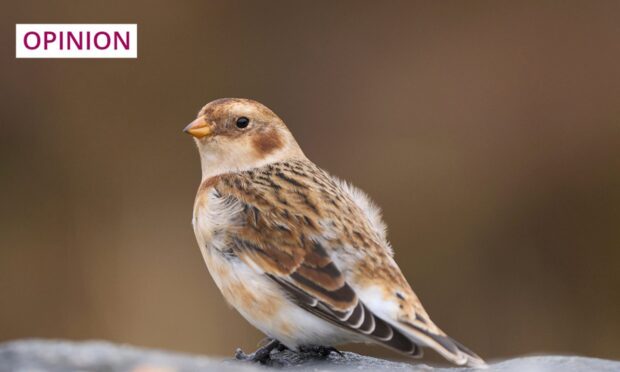I do love a snow bunting.
As a winter enthusiast, it’s hard not to, given they’re happy in cold environments, have “snow” in their name, and their collective noun (in North America, at least) is a “drift”.
Hardy wee things, slightly larger than a sparrow, they’re pretty much the only small bird up high at this time of year. The characteristic tsip-tsip of the meadow pipits has long gone, replaced instead by the snow bunting’s gorgeous, soft, chirruping flight call.
Not that they’re ubiquitous like meadow pipits, of course. On the coast, snow bunting flocks can be a hundred strong, but in the hills I rarely see more than one or two at a time. In some years, I don’t see any at all. This autumn, however, I’ve seen three on Lochnagar, a flock of 12 in Morvern and, this week, a rare pair on East Lomond in Fife.
Watching the Fife pair foraging just three metres away, they weren’t as white in colour as I remembered. I’ve always lumped snow buntings in with our other winter specialists, the mountain hare and the ptarmigan, as creatures that turn almost completely white as winter approaches. But, no, that’s not what snow buntings do.
Yes, their plumage does turn much whiter in order to give them camouflage against the snow, it just doesn’t happen in winter. Somewhat counterintuitively, it happens in summer.
Snow buntings are, after all, a true Arctic bird. They breed farther north than almost all other bird species, in places like Alaska, Canada, Greenland, Scandinavia and northern Russia. But, hardy as they are, the Arctic winter is too harsh even for them. Food is scarce. So, in autumn, they fly south, to the warmer grasslands, fields and coasts of temperate latitudes, in search of seeds and invertebrates.
Eun an t-sneachda – bird of the snow
An estimated 15,000 snow buntings, mostly from Iceland, spend winter in the UK. Their winter plumage is, therefore, more in tune with less snowy winter locations. They still have more white than your average wee bird, mainly on their wings as they fly about, but they have a sandy brown back and distinctive, almost rosy cheeks.
When snow buntings return to the Arctic in the spring, they nest in dark crevices between rocks, and forage on the fresh green growth at the edge of snowfields, or on the snow itself, feeding on stranded insects. The summer plumage of the breeding males matches this environment – mostly snow-white, but with a black back, enabling them to blend into their surroundings.
Given their preference for snow in summer, you’d be forgiven for thinking you’d need to follow snow buntings into the Arctic Circle to see them in their whitest plumage. But, no. For, while 15,000 snow buntings depart our shores in spring, a tiny handful do not.
Approximately 60 pairs are resident all year round in Scotland, up in our highest hills. We are, however, at the extreme south of the snow bunting’s summer range. A summer survey in 2011 found Scottish snow buntings at altitudes between 645 metres and 1,322 metres, but the median altitude – the sweet spot, if you like – for breeding snow buntings was 1,135 metres.
Unsurprisingly, it’s in the Cairngorms, with its sub-arctic plateaux, where you’ll find 80% of the Scottish population
That’s high. Only 25 of the 282 Munros reach 1,135 metres, so breeding snow buntings are naturally confined to places like Ben Nevis, Ben Alder and a few hills farther north. But, unsurprisingly, it’s in the Cairngorms, with its sub-arctic plateaux, where you’ll find 80% of the Scottish population.
In summer, the snow buntings breed on the plateaux, flitting around snow patches. In winter, as conditions deteriorate, they retreat down the hill. Some don’t go far, and can often be seen around the Cairngorm Mountain ski centre. Little wonder their Gaelic name is eun an t-sneachda: bird of the snow.
Do snow buntings bring the snowfall with them?
Given their tiny breeding UK population, resident snow buntings are Amber-Listed in terms of conservation concern. And, while they appear to have been stable in recent times, one wonders what the steady decrease in summer snow cover will mean for them in the longer term.
At this point, I should tell you that the day after my Fife sighting, quite by chance, I stumbled upon a tweet I posted in the very same week in November 2017: “Just saw a snow bunting on East Lomond. I choose to believe this is an omen of a ridiculously cold and snowy winter“.
That was rather prophetic. The winter of 2017-2018 was a rare colder-than-average one, with frequent snowy outbursts between November and February, culminating in the infamous Beast from the East.
Of course, it can’t be the case that every snow bunting sighting on East Lomond is a sign of things to come. But, as a winter fan, hard on his luck in recent years, I admit I’m risking a little optimism and punting on a bunting.
Ben Dolphin is an outdoors enthusiast, countryside ranger and former president of Ramblers Scotland












Conversation